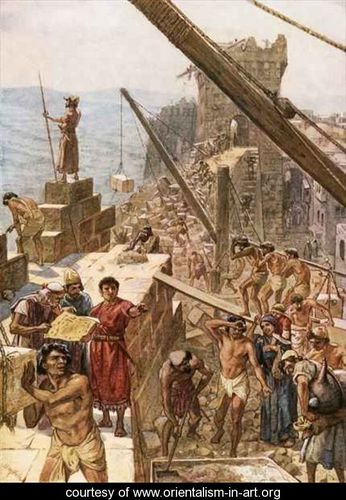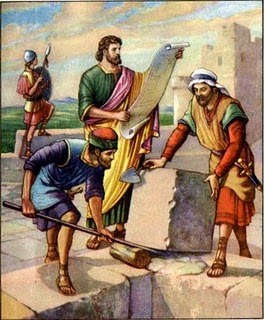- They were the daughters of Shallum, the son of Halohesh who was the “ruler of half of Jerusalem”;
- They helped their father repair a portion of the old gate of Jerusalem;
- They were the only women Nehemiah mentioned among those who helped re-build the walls of Jerusalem;
- It took Nehemiah and his workers 53 days to re-build the Jerusalem walls (Nehemiah 6:15).
- The Jews who rebuilt the temple faced much opposition from surrounding people who did not want to see the city rebuilt and did not want the Jews to return to their former power. In Nehemiah 4: 14-23 it mentions how those who worked on the gates carried weapons with them and took turns standing guard while the other half of the workers worked. Nehemiah described that, “…everyone with one of his hands wrought in the work and with the other hand held a weapon.” It is probable that the daughters of Shallum also carried weapons and participated in defending the workers because Nehemiah emphasized that “For the builders, every one had his sword girded by his side, and so he builded (Nehemiah 4:17, emphasis added).”
- In Nehemiah 7:45 a list of all the Jewish families who returned to Jerusalem is given. Among them is listed the children of Shallum, whose occupation was given as a porter. It is unclear but this might be the same Shallum whose daughters helped with the rebuilding. If that is the case then his daughters may have assisted with the building by porting the supplies and material for the temple. On the other hand, this might not be the same Shallum seeing as he was referred to as the “ruler of half of Jerusalem” indicating that may have already been living in Jerusalem when Nehemiah returned.
- Most Old Testament scholars feel that the word “daughters” is the correct translation. Yet some scholars, who don’t feel like it would have been feasible for Old Testament women to have assisted in the re-building, say that it is common for hamlets which grow up around cities to be called “daughters” and that this may have been what was meant in reference to Shallum and his daughters. Source
As I’ve thought these unnamed daughters I see the value in teaching girls and young women how to work and build with their hands. The daughters of Shallum had learned and developed their building skills years before Nehemiah ever began his work on the Jerusalem walls. Their father, and possibly their mother, had taught them and trained them so well that when the time came they were able to contribute in a meaningful and important way to the re-building of Jerusalem. I can’t help but feel that the young women of the future are going to be facing a hard world, one in which they will face physical as well as spiritual trials. Will the women of the future be prepared, like the daughters of Shallum were, to handle the trials that come? Will they be prepared with a good work ethic and valuable skills? Will they be ready to rebuild?
It seems to me that if it is important to teach young men nurturing skills when they are young so that they will be able to contribute meaningfully to their families then it is also important to teach young women the life skills that will help them as they build their families and communities. I know that my husband would really appreciate it if I knew how to change a flat tire or fix the toilet when it breaks! I still have a lot to learn 😉
- What spiritual significance do you see in women being included in the re-building of Jerusalem?
- What was it about the daughters of Shallum that impressed Nehemiah enough that he mentioned them specifically in his text? Was it just because their presence was unusual? Or because they performed their work especially well or were a valuable addition to the work force?
- Who is the “handy” one at your house? Husband or wife? Daughter or son? How were those skills developed or recognized?
- In Nehemiah 2:6 Nehemiah mentioned that when we was speaking with the King about returning to rebuild Jerusalem that the queen was also sitting by him. This queen is probably Queen Vashti, since this would have been before Esther’s time. Why do you think he mentions her? Do you think perhaps she said something that influenced the King on his behalf?




I think maybe they may not have been doing man's work, but woman's work. Like clothing the men, cooking for them, bringing them water that sort of thing.
Maybe Nehemiah was honoring their contribution, even though they didn't lay the stones they made the building possible through their service. Sort of like the women in the church who served the men who were building the early temples like Kirtland and Nauvoo. (as well as sewing for the temples and donating their chinaware for the outside of the Kirtland temple)
I always feel like we lay the groundwork for the great things that our children and husbands do. If we're not there to do our part (the part no one ever sees or acknowledges) then the big grand things our husbands and children want to do don't get done. We nurture, and they build walls and temples. Maybe Nehemiah was just bringing attention our special role?
Kimberly,
I like your thoughts about this and your comparison to the women in Nauvoo. I think you are right, I bet there were lots of women that assisted the laborers on the walls by serving and helping them. Women really do lay the foundation for big accomplishments.
Yet I'm inclined to think, from the scriptural text and other things I've read about them, that they were really "re-building" with their father. The scriptures seem to be pretty clear that these women were actually helping with the construction of the walls. Which I think it is pretty neat. Yet we will really never know what their contribution was exactly, so we can always speculate!
My daughters and i would definitely be doing the bricks and mortar. We are feminine ladies who wear dresses only, but we do dirty work when it is necessary! Dont women take care of horses and such